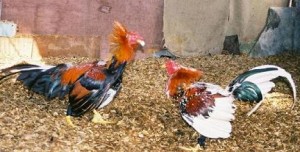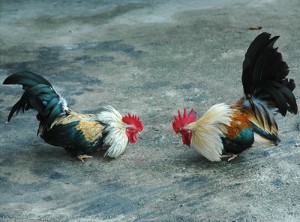ROOSTER TIME IN CUBA. VIDEO
It was said in the 1940s that no one in the world surpassed Cubans as far as raising fighting roosters or concerns.
There was in those years excellent breeders in Las Villas, Camagüey and Havana. Proof of this is that between 1946 and 1947 the Ministry of Agriculture granted export permits for more than 2,000 roosters which mostly went to Puerto Rico as well as Mexico, Venezuela and Colombia. It was conquered supremacy, said a specialist, spur tip.
https://youtu.be/_lFCa0szNwk
On that date, however, entered the country about 700 roosters breeders purchased Jerez Cadiz, Almeria, Seville and Jerez. Despite its price-cost each about $ 125, were much lower than those born and raised on the island.
Decisive factors justified the poor class of such imported copies. The civil war in Spain caused shortages and higher prices of many food items. Missed the wheat, which is the staple food of the hacks in this country and to this challenge many pups disappeared.
That did not stop to ponder its merchandise vendors Andalusians as if it were gold. They came to Cuba with the cigarette in his mouth and lies in the language. They said “This rooster knocked the Alcázar of Toledo”. Or “This is sorrel strip up to the cathedral of Seville.” Others claimed: “My cock has fought ten major exhibitions and has never been defeated.” But when the roosters truth in the words of its vendors, many accumulated prowess, fled to receive the first blow in the eye. Buyers were slow to understand Cubans who had been scammed. Roosters were purchased in the markets of Andalusia for twenty or thirty pesetas (two or three pesos of the time) to be resold in Havana, where the price of a rooster export ranged from forty to seventy dollars.
At that time there were many hurdles cock in this capital. The National, corner of Texas, and the fence Havana, in the square of Freshwater, attracted a large audience for the quality of its functions and excellent location. It was not far behind the fence Guanabacoa, in the town of that name, who was reborn after living a precarious life because their owners did not bother to make the timely announcement of its functions. Beyond that error and the installation entirely revamped, Guanabacoa fence was becoming one of the main gallísticos habaneros.
Agencies/CiroBianchiRoss/InternetPhotos/TheCubanHistory.com
THE CUBAN HISTORY, HOLLYWOOD.
Arnoldo Varona, Editor.
LOS TIEMPOS DE GALLOS EN CUBA
Se decía en la década de 1940 que nadie en el mundo superaba a los cubanos en lo que a la cría de gallos finos o de pelea se refiere. Había en esos años excelentes criadores en Las Villas, Camagüey y La Habana. Prueba de ello es que entre 1946 y 1947 el Ministerio de Agricultura concedió permisos de exportación para más de 2 000 gallos que en su mayoría fueron a parar a Puerto Rico y también a México, Venezuela y Colombia. Fue una primacía conquistada, decía un especialista, a punta de espuela.
En esa fecha, en cambio, entraron al país unos 700 gallos jerezanos comprados a criadores de Cádiz, Almería, Sevilla y Jerez. Pese a su precio –costaba cada uno de ellos alrededor de 125 dólares- eran muy inferiores a los nacidos y criados en la Isla.
https://youtu.be/_lFCa0szNwk
Factores decisivos justificaban la pobre clase de esos ejemplares importados. La guerra civil ocasionó en España la escasez y el encarecimiento de muchos renglones alimenticios. Faltó el trigo, que es la base de la alimentación de los plumíferos en ese pais y ante ese imperativo muchas crías desaparecieron.
Eso no fue obstáculo para que vendedores andaluces ponderaran su mercancía como si fuese de oro. Llegaban a Cuba con el cigarrillo en la boca y la mentira en la lengua. Decían “Este gallo tumbó al Alcázar de Toledo”. O “Este alazán se faja hasta con la catedral de Sevilla”. Otros aseguraban: “Mi gallo ha peleado en unas diez grandes ferias y nunca ha sido derrotado”. Pero a la hora de la verdad los gallos que, al decir de sus vendedores, tantas proezas acumulaban, huían al recibir el primer golpe en un ojo. Los compradores cubanos demoraban en comprender que habían sido estafados. Eran gallos comprados en los mercados de Andalucía por veinte o treinta pesetas (dos o tres pesos cubanos de los de entonces) para ser revendidos en La Habana, donde el precio de un gallo de exportación oscilaba entre los cuarenta y los setenta pesos.
En esa época existían muchas vallas de gallos en esta capital. La Nacional, de la Esquina de Tejas, y la valla Habana, en la plazoleta de Agua Dulce, atraían a un público numeroso por la calidad de sus funciones y excelente ubicación. No quedaba muy atrás la valla Guanabacoa, en la localidad de ese nombre, que renació luego de vivir una vida en precario porque sus dueños no se preocupaban de hacer el anuncio oportuno de sus funciones. Superado ese error y, con la instalación remozada por entero, la valla Guanabacoa fue convirtiéndose en uno de los principales centros gallísticos habaneros.
Agencies/CiroBianchiRoss/InternetPhotos/TheCubanHistory.com
THE CUBAN HISTORY, HOLLYWOOD.
Arnoldo Varona, Editor.





